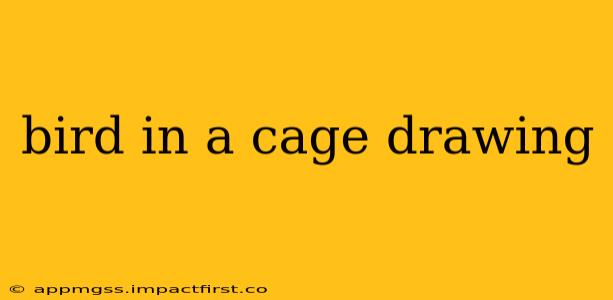Drawing a bird in a cage might seem like a simple subject, but it offers a surprising range of artistic possibilities. From capturing the delicate details of feathers to conveying the mood and emotion of confinement, this seemingly straightforward image can become a powerful piece of art. This guide will explore various techniques and considerations to help you create a compelling bird in a cage drawing.
What are the different ways to draw a bird in a cage?
The approach you take to drawing a bird in a cage depends heavily on your artistic style and the message you wish to convey. Realism focuses on accurate representation, while impressionism prioritizes capturing the essence of the scene through color and light. Abstract styles might emphasize shapes and forms, simplifying the bird and cage into their basic components. Consider the overall mood you want to create: is it one of melancholy, freedom, hope, or something else entirely? This will heavily influence your choice of style and technique.
How do I draw a realistic bird in a cage?
Creating a realistic bird in a cage drawing requires careful observation and attention to detail. Start with basic shapes to establish the overall composition: a circle or oval for the bird's body, lines for the cage bars, and a rectangle or square for the cage itself. Then, gradually add details: the intricate patterns of the feathers, the texture of the cage material (wood, metal, etc.), and subtle shading to create depth and dimension. Observing reference photos of various bird species and cage types is crucial for achieving realism. Pay close attention to the light source and how it affects the shadows and highlights on both the bird and the cage.
What materials should I use for a realistic bird drawing?
For realism, consider using high-quality pencils (ranging from H for light sketching to B for dark shading), charcoal for rich darks, and perhaps even colored pencils or pastels for adding subtle color variations in the feathers and cage. Smooth drawing paper is recommended to allow for fine detail work.
How to draw a simple bird in a cage for beginners?
Beginners can start with simplified shapes and forms. Instead of meticulously rendering each feather, focus on the overall shape of the bird. Use basic geometric shapes to build the bird's body and head, and represent the cage with simple lines and bars. This approach allows you to concentrate on the overall composition and practice fundamental drawing skills like proportion, perspective, and shading.
What are some easy techniques for drawing a bird in a cage?
Simple techniques for beginners include using light pencil strokes for sketching, gradually adding darker lines for definition, and using basic shading techniques like hatching and cross-hatching to create depth. Focus on capturing the essence of the bird and cage, rather than getting bogged down in minute details.
How do I add shadows and highlights to my bird in a cage drawing?
Shading and highlighting are crucial for adding depth and realism to your drawing. Observe the light source and how it affects the different parts of the bird and cage. Use darker tones to create shadows and lighter tones to create highlights. Experiment with different shading techniques, such as hatching, cross-hatching, and blending, to achieve a variety of textures and tones.
What are some different styles of bird in a cage drawings?
The possibilities are endless! You can explore different artistic styles, such as:
- Realistic: Focus on accurate representation of the bird and cage.
- Impressionistic: Capture the mood and atmosphere through color and light.
- Abstract: Simplify the image into basic shapes and forms.
- Surreal: Combine realistic elements with fantastical or dreamlike imagery.
- Cartoonish: Create a simplified, playful depiction of the bird and cage.
By exploring these various styles and techniques, you can create a unique and expressive bird in a cage drawing that reflects your personal artistic vision. Remember that practice is key, and don't be afraid to experiment! The more you draw, the better you will become at capturing the details and expressing your creative ideas.
